厦门大学:《海洋环境化学》课程教学资源(PPT课件)Chap 09 海洋合成有机化合物污染 Maine Persistent Organic Pollutants(POPs)pollution(part 1/2)
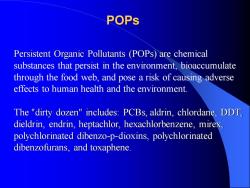
POPs Persistent Organic Pollutants (POPs) are chemical substances that persist in the environment, bioaccumulate through the food web, and pose a risk of causing adverse effects to human health and the environment. The "dirty dozen" includes: PCBs, aldrin, chlordane, DDT, dieldrin, endrin, heptachlor, hexachlorbenzene, mirex, polychlorinated dibenzo-p-dioxins, polychlorinated dibenzofurans, and toxaphene
POPs Persistent Organic Pollutants (POPs) are chemical substances that persist in the environment, bioaccumulate through the food web, and pose a risk of causing adverse effects to human health and the environment. The "dirty dozen" includes: PCBs, aldrin, chlordane, DDT, dieldrin, endrin, heptachlor, hexachlorbenzene, mirex, polychlorinated dibenzo-p-dioxins, polychlorinated dibenzofurans, and toxaphene
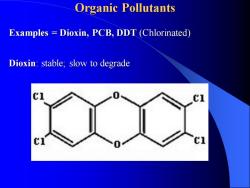
Organic Pollutants Examples = Dioxin, PCB, DDT (Chlorinated) Dioxin: stable; slow to degrade
Organic Pollutants Examples = Dioxin, PCB, DDT (Chlorinated) Dioxin: stable; slow to degrade
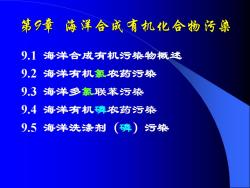
第9章 海洋合成有机化合物污染 9.1 海洋合成有机污染物概述 9.2 海洋有机氯农药污染 9.3 海洋多氯 9.4 海洋有机磷 9.5 海洋洗涤剂(磷)污染
第9章 海洋合成有机化合物污染 9.1 海洋合成有机污染物概述 9.2 海洋有机氯农药污染 9.3 海洋多氯 9.4 海洋有机磷 9.5 海洋洗涤剂(磷)污染
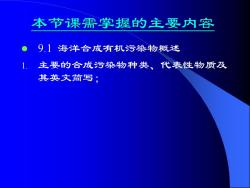
本节课需掌握的主要内容 ⚫ 9.1 海洋合成有机污染物概述 1. 主要的合成污染物种类、代表性物质及 其英文简写;
本节课需掌握的主要内容 ⚫ 9.1 海洋合成有机污染物概述 1. 主要的合成污染物种类、代表性物质及 其英文简写;
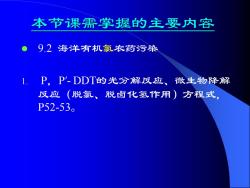
本节课需掌握的主要内容 ⚫ 9.2 海洋有机氯农药污染 1. P,P′- DDT的光分解反应、微生物降解 反应(脱氯、脱卤化氢作用)方程式, P52-53
本节课需掌握的主要内容 ⚫ 9.2 海洋有机氯农药污染 1. P,P′- DDT的光分解反应、微生物降解 反应(脱氯、脱卤化氢作用)方程式, P52-53
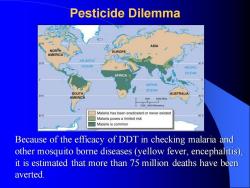
Pesticide Dilemma Because of the efficacy of DDT in checking malaria and other mosquito borne diseases (yellow fever, encephalitis), it is estimated that more than 75 million deaths have been averted
Pesticide Dilemma Because of the efficacy of DDT in checking malaria and other mosquito borne diseases (yellow fever, encephalitis), it is estimated that more than 75 million deaths have been averted

Pesticide Characteristics Pesticides are toxins used against organisms that interfere with human activities or welfare. Pesticides are grouped according to the pests they target – insecticides kill insects, herbicides kill plants, fungicides kill fungi, and rodenticides kill rats and mice. Agriculture uses ~85% of the almost 3 millions tons of pesticides used each year
Pesticide Characteristics Pesticides are toxins used against organisms that interfere with human activities or welfare. Pesticides are grouped according to the pests they target – insecticides kill insects, herbicides kill plants, fungicides kill fungi, and rodenticides kill rats and mice. Agriculture uses ~85% of the almost 3 millions tons of pesticides used each year

Pesticide Characteristics Many plant-derived pesticides (e.g., pyrethrin from chrysanthemums) or their derivatives are easily broken down by microorganisms and do not persist long in the environment. Most of the second generation man-made pesticides (e.g., DDT) are broad spectrum and slow to degrade (half-life 15 years in soil and as much as 150 years in aquatic environments)
Pesticide Characteristics Many plant-derived pesticides (e.g., pyrethrin from chrysanthemums) or their derivatives are easily broken down by microorganisms and do not persist long in the environment. Most of the second generation man-made pesticides (e.g., DDT) are broad spectrum and slow to degrade (half-life 15 years in soil and as much as 150 years in aquatic environments)
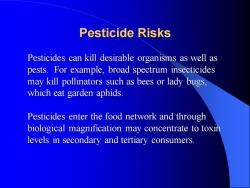
Pesticide Risks Pesticides can kill desirable organisms as well as pests. For example, broad spectrum insecticides may kill pollinators such as bees or lady bugs, which eat garden aphids. Pesticides enter the food network and through biological magnification may concentrate to toxin levels in secondary and tertiary consumers
Pesticide Risks Pesticides can kill desirable organisms as well as pests. For example, broad spectrum insecticides may kill pollinators such as bees or lady bugs, which eat garden aphids. Pesticides enter the food network and through biological magnification may concentrate to toxin levels in secondary and tertiary consumers
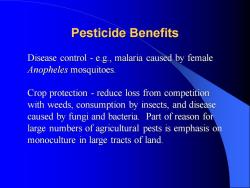
Pesticide Benefits Disease control - e.g., malaria caused by female Anopheles mosquitoes. Crop protection - reduce loss from competition with weeds, consumption by insects, and disease caused by fungi and bacteria. Part of reason for large numbers of agricultural pests is emphasis on monoculture in large tracts of land
Pesticide Benefits Disease control - e.g., malaria caused by female Anopheles mosquitoes. Crop protection - reduce loss from competition with weeds, consumption by insects, and disease caused by fungi and bacteria. Part of reason for large numbers of agricultural pests is emphasis on monoculture in large tracts of land
按次数下载不扣除下载券;
注册用户24小时内重复下载只扣除一次;
顺序:VIP每日次数-->可用次数-->下载券;
- 厦门大学:《海洋环境化学》课程教学资源(PPT课件)Chap 08 Oil pollution of the sea 海洋石油污染(part 2/2).ppt
- 厦门大学:《海洋环境化学》课程教学资源(PPT课件)Chap 07 Oil pollution of the sea 海洋石油污染(part 1/2).ppt
- 厦门大学:《海洋环境化学》课程教学资源(PPT课件)Chap 06 Marine eutrophication and Red tide(case study)大鹏湾环境与赤潮的研究.ppt
- 厦门大学:《海洋环境化学》课程教学资源(PPT课件)Chap 05 Marine eutrophication and Red tide(part 3).ppt
- 厦门大学:《海洋环境化学》课程教学资源(PPT课件)Chap 04 Marine eutrophication and Red tide(part 2).ppt
- 厦门大学:《海洋环境化学》课程教学资源(PPT课件)Chap 03 Marine eutrophication and Red tide(part 1).ppt
- 厦门大学:《海洋环境化学》课程教学资源(PPT课件)Chap 02 Marine oxygen-demanded organic pollution.ppt
- 厦门大学:《海洋环境化学》课程教学资源(PPT课件)Chap 12 The protection of marine environment 海洋环境保护.ppt
- 厦门大学:《海洋环境化学》课程教学资源(PPT课件)Chap 11 Marine radioactive and thermal pollution.ppt
- 厦门大学:《海洋环境化学》课程教学资源(PPT课件)Chap 01 Mechanisms and problems of marine pollution.ppt
- 厦门大学:《海洋生态学》课程教学资源(PPT课件)第十三章 保护海洋生物多样性.ppt
- 厦门大学:《海洋生态学》课程教学资源(PPT课件)第十二章 海洋污染和赤潮现象.ppt
- 厦门大学:《海洋生态学》课程教学资源(PPT课件)第十一章 海洋渔业资源的科学管理.ppt
- 厦门大学:《海洋生态学》课程教学资源(PPT课件)第十章 海洋主要生态系统类型.ppt
- 厦门大学:《海洋生态学》课程教学资源(PPT课件)第九章 海洋生态系统的分解作用与生物地化循环.ppt
- 厦门大学:《海洋生态学》课程教学资源(PPT课件)第八章 海洋生态系统的能流及次级生产力.ppt
- 厦门大学:《海洋生态学》课程教学资源(PPT课件)第七章 海洋初级生产力.ppt
- 厦门大学:《海洋生态学》课程教学资源(PPT课件)第六章 生物群落的组成、结构和生态演替.ppt
- 厦门大学:《海洋生态学》课程教学资源(PPT课件)第五章 海洋生物群落中的种间关系.ppt
- 厦门大学:《海洋生态学》课程教学资源(PPT课件)第四章 生态系统中的生物种群.ppt
- 厦门大学:《海洋环境化学》课程教学资源(PPT课件)Chap 09 海洋合成有机化合物污染 Maine Persistent Organic Pollutants(POPs)pollution(part 2/2).ppt
- 福州大学:《水污染控制工程》课程教学资源(PPT课件)第一章 污水水质与污水出路.ppt
- 福建船政交通职业学院:《环境监测》课程教学实验指导书(共十六个实验).doc
- 福建船政交通职业学院:《环境监测》课程电子教案(授课讲义,负责人:陈健).doc
- 福建船政交通职业学院:《环境监测》课程教学课件(PPT讲稿)第一章 绪论.ppt
- 福建船政交通职业学院:《环境监测》课程教学课件(PPT讲稿)第三章 大气和废气监测.ppt
- 福建船政交通职业学院:《环境监测》课程教学课件(PPT讲稿)第二章 水和废水监测.ppt
- 福建船政交通职业学院:《环境监测》课程教学课件(PPT讲稿)第七章 噪声污染监测.ppt
- 福建船政交通职业学院:《环境监测》课程教学课件(PPT讲稿)第九章 监测过程的质量保证.ppt
- 福建船政交通职业学院:《环境监测》课程教学课件(PPT讲稿)第五章 土壤污染监测.ppt
- 福建船政交通职业学院:《环境监测》课程教学课件(PPT讲稿)第八章 环境放射性监测.ppt
- 福建船政交通职业学院:《环境监测》课程教学课件(PPT讲稿)第六章 生物污染监测.ppt
- 福建船政交通职业学院:《环境监测》课程教学课件(PPT讲稿)第四章 固体废物监测.ppt
- 新疆大学:《景观生态学》课程教学大纲.pdf
- 新疆大学:《景观生态学》课程教学课件(PPT讲稿)第七章 景观生态学与土地持续利用.ppt
- 新疆大学:《景观生态学》课程教学课件(PPT讲稿)第三章 景观动态变化.ppt
- 新疆大学:《景观生态学》课程教学课件(PPT讲稿)第九章 景观生态学的应用.ppt
- 新疆大学:《景观生态学》课程教学课件(PPT讲稿)第二章 景观结构及要素的生态作用.ppt
- 新疆大学:《景观生态学》课程教学课件(PPT讲稿)第五章 土地/景观动态过程及模型.ppt
- 新疆大学:《景观生态学》课程教学课件(PPT讲稿)第八章 遥感、地理信息系统在景观生态学中的应用.ppt
